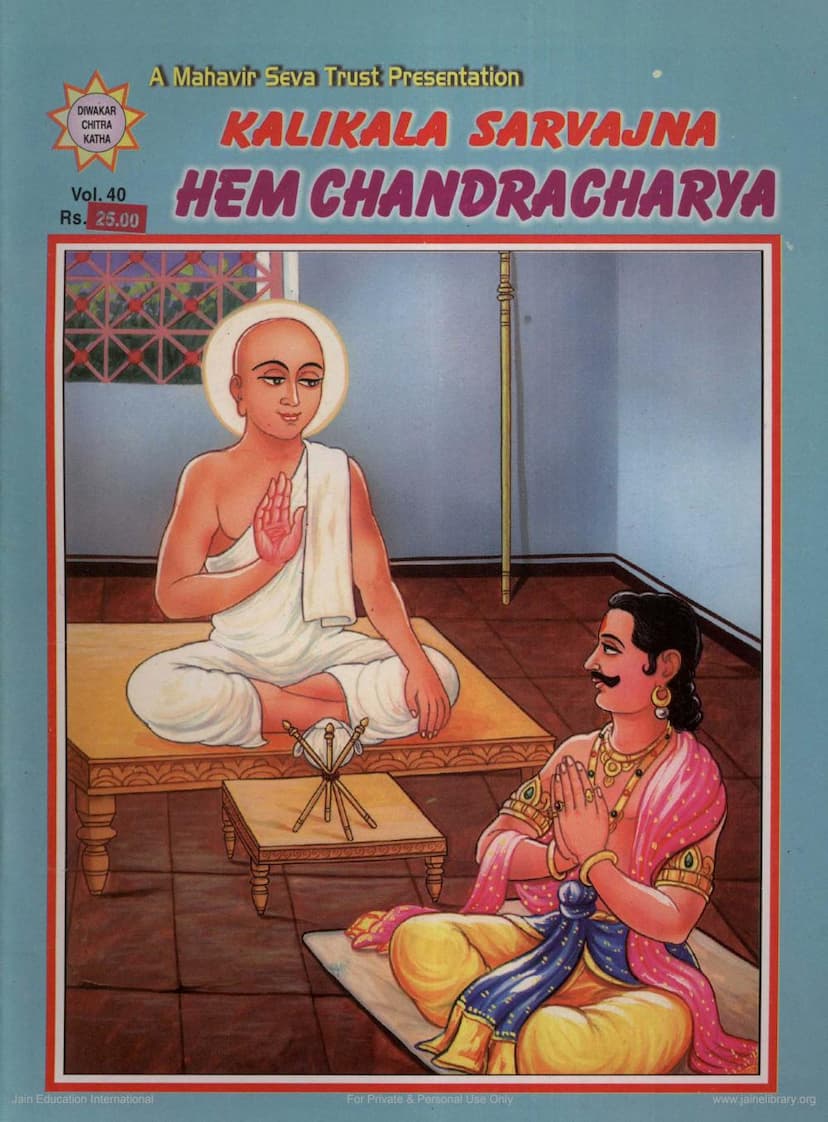Hemchandracharya Diwakar Chitrakatha 040
Added to library: September 1, 2025

Summary
Here's a comprehensive summary of the provided Jain text, "Hemchandracharya Diwakar Chitrakatha 040":
This book, part of the "Diwakar Chitrakatha" series by Mahavir Seva Trust, focuses on the life and achievements of Acharya Shri Hemachandra Suri, a pivotal figure in Jain tradition, particularly in western India. He is revered as "Kalikala Sarvajna" (Omniscient of the Kali Yuga). The volume is divided into two parts, with this being the first, detailing his early life and his significant influence on King Kumarpal of Gujarat.
Early Life and Initiation of Hemachandra:
- The narrative begins with the birth of Hemachandra, originally named Changadev, to merchant Chachig and his wife Pahinidevi in Dhandhuka. Pahinidevi's dream of receiving a divine gem foreshadowed her son's spiritual destiny.
- Young Changadev showed early signs of wisdom and modesty, impressing Gurudev Shri Devachandra Suri. Recognizing the gem-like qualities in the child, Devachandra Suri predicted he would become his disciple.
- Changadev was deeply drawn to the spiritual life and expressed a desire to find God through hardship, even when faced with his father's attachment.
- At the age of nine, Changadev was formally initiated and named Muni Somachandra.
Pursuit of Knowledge and Divine Blessing:
- Muni Somachandra, inspired by the omniscience of Ganadhar Gautam Swami, sought the secret to acquiring such profound knowledge.
- Gurudev Devachandra Suri advised him to travel to Kashmir, the seat of Saraswati, the goddess of learning, to invoke her blessings.
- However, while on the way to Kashmir, Muni Somachandra meditated in an ancient Jain temple in Khambhat. Impressed by his devotion, Goddess Saraswati appeared and granted him the boon of becoming an accomplished scholar, negating the need to travel to Kashmir.
- Muni Somachandra's enhanced intellect was demonstrated when he encountered the seemingly miserly merchant Dhanad in Nagpur. Dhanad's gold coins had turned to coal due to his miserliness, but a glance from Muni Somachandra restored them, highlighting the power of spiritual practice and the influence of virtuous souls.
The Rise of Acharya Hemachandra:
- After returning to Patan, Muni Somachandra expressed a desire to visit Gaud country, known for scholars of miraculous powers.
- On his journey, he met an elderly person who claimed to possess all knowledge and offered to share it if taken to Girnar. This turned out to be a divine test, and they were magically transported to the Girnar mountain.
- There, the protecting goddess of the Jain order appeared and bestowed divine mantras and herbs upon Muni Somachandra and his companion Devendra Suri, empowering them to promote Jainism and protect devotees. While Somachandra retained this knowledge, Devendra Suri forgot it.
- Upon his return to Patan, Acharya Devachandra Suri, recognizing Muni Somachandra's unique talents and potential, proposed elevating him to the status of Acharya.
- The Jain Sangh organized an investiture ceremony, and Muni Somachandra was renamed Acharya Hemachandra Suri, signifying his luminous personality and his ability to enhance the glory of the Jain order.
Influence on King Jaisingh Siddharaj and the Creation of "Siddha Hemchandra Shabdanushasan":
- King Jaisingh Siddharaj, a powerful ruler, celebrated his victory over Malava and sought to elevate Gujarat's status in art and literature.
- He challenged any Gujarati scholar to write a grammar as renowned as King Bhoj's "Sarasvati Kanthabharan."
- Acharya Hemachandra accepted the challenge, stating he could write a better grammar.
- With the king's support, which included procuring rare grammars from Kashmir, Acharya Hemachandra composed "Siddha Hemchandra Shabdanushasan," a comprehensive grammar of approximately 125,000 couplets.
- The book was accorded immense honor, paraded through the city on an elephant, and the king decreed it be taught in all schools in Gujarat, ensuring its widespread dissemination.
The Prophecy of Kumarpal and his Ascent to the Throne:
- King Siddharaj, who had no heir, sought Hemachandra's guidance on his successor.
- Through meditation, Acharya Hemachandra learned from Goddess Ambika that Siddharaj would not have a son. Instead, Kumarpal, the son of Tribhuvanpal, would ascend the throne.
- Siddharaj, apprehensive of Kumarpal's bravery and arrogance, ordered his arrest.
- The narrative then details the lineage of the Chaulukya dynasty, leading up to Siddharaj and his cousin Tribhuvanpal, Kumarpal's father.
- Kumarpal, a brave and righteous individual, encountered Acharya Hemachandra while evading Siddharaj's spies. The Acharya recognized Kumarpal's potential and predicted his future kingship, advising him to promote Jainism and ahimsa upon his ascension.
- With the help of minister Udayan and a clever hiding place arranged by Acharya Hemachandra, Kumarpal survived Siddharaj's attempts to capture him.
- Upon Siddharaj's death, Kumarpal was crowned King of Gujarat.
King Kumarpal's Devotion and Reforms:
- Kumarpal expressed profound gratitude to Acharya Hemachandra and pledged to uphold the Jain religion and eradicate violence and vices from his kingdom.
- Influenced by the Acharya, Kumarpal, who was initially a devotee of Shiva, embraced Jainism and the principle of ahimsa. He commissioned the construction of numerous Jain temples, including the Tribhuvanpal Chaitya in Patan.
- The text then describes Kumarpal's efforts to renovate the ancient Somanath Mahadev temple. He took vows of renouncing meat and alcohol until its completion, demonstrating his devotion.
- He also took further vows to atone for past sins.
- Kumarpal, under Hemachandra's guidance, took steps to eradicate vices from his state, even resorting to symbolic processions and exile for those who refused to abandon them.
- The book concludes by promising to detail Kumarpal's further contributions to the propagation of ahimsa and the prosperity of Gujarat in the second part.
In essence, Volume 40 of the "Hemachandracharya Diwakar Chitrakatha" chronicles the formative years of Acharya Hemachandra Suri, his intellectual awakening, and his profound influence on King Kumarpal, setting the stage for a golden era of Jainism, art, literature, and social reform in Gujarat under their combined guidance.